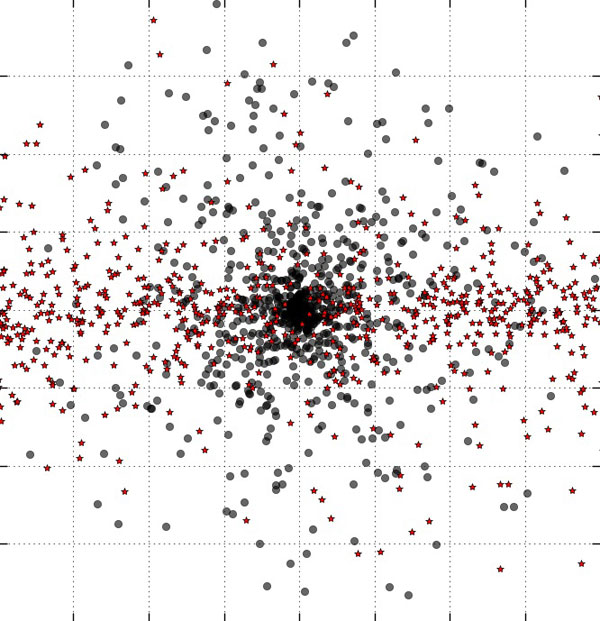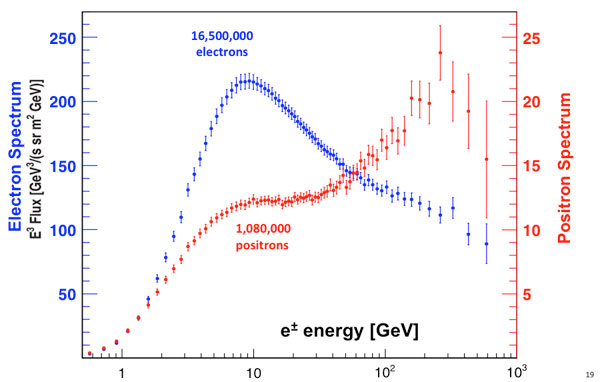Our galaxy's center region is producing gamma rays, but astronomers are still debating whether pulsars or dark matter are the source. Three recent studies tackle the debate head-on.
An unexpected number of gamma rays emanate from our galaxy’s center — unexpected because, as of yet, astronomers still don’t understand what’s producing this high-energy radiation. The primary options span the spectrum of the exotic: gamma-ray pulsars vs. dark matter particles. Recent studies pave the way for pulsars and narrow down dark matter’s playing field.
What is the Gamma-Ray Excess?

NASA / A. Mellinger / Central Michigan Univ. / T. Linden / Univ. of Chicago
The Fermi Large Area Telescope first painted a picture of the gamma-ray sky. Several teams of scientists analyzing Fermi data subtracted all known sources from this map, such as pulsars, stellar-mass black holes, and spread-out emission coming from interstellar gas. But even after every source we know about had been removed, our galactic center still appeared as a bright gamma-ray glow. (The Andromeda Galaxy was recently found to have a similar central glow.)
Some groups suggested that the gamma rays could be produced via dark matter particle collisions. Unlike ordinary matter, dark matter particles are their own antimatter particles. If ever the twain shall meet, they annihilate each other, producing gamma rays and perhaps other secondary subatomic particles.
Still, given that dark matter particles have yet to be detected in the lab (where they are spotted not by collisions with each other but by rare interactions with ordinary matter), many scientists have been hesitant to accept that explanation. Pulsars, which also produce gamma rays, are the preferred alternative. But pulsars have proven intransigent: attempts to detect them at radio wavelengths in large enough numbers to explain the excess have failed.

Greg Stewart / SLAC National Accelerator Laboratory
Gamma-ray Pulsars
Now, Mattia di Mauro, Eric Charles, and Matthew Wood (SLAC National Accelerator Lab), as well as the rest of the Fermi-LAT Collaboration, have published a new study picking out gamma-ray pulsar candidates from 7½ years of Fermi observations analyzed using the most recent data pipeline, known as “Pass 8.” The paper has been submitted to Astrophysical Journal (preprint available here).
Looking within a box centered on the galaxy’s center, 40° on a side, the team carefully picked out about 100 point sources that are likely to be gamma-ray pulsars. These pulsars represent the tip of an iceberg — there are probably many more point sources that Fermi can't resolve. But based on how these pulsar candidates are spread out on the sky, as well as their brightnesses, the team concludes that they can easily explain the gamma-ray excess.

NASA / DOE / Fermi LAT Collaboration
That said, it’s important to remember that these are pulsar candidates — they still need to be confirmed as pulsars, namely by detecting pulsations either in the radio or gamma rays.
Tansu Daylan (Harvard University), who proposed a dark matter explanation for the gamma-ray excess, agrees this new analysis is important. “However,” he adds, “until we have a smoking signature for pulsars, I think both hypotheses should be considered viable.”
Another paper adds theoretical backing for the pulsar scenario. In a paper published in Nature Astronomy on May 22nd (preprint available here), Roland Crocker (Australian National University) and colleagues model what a population of white dwarf stars in the Milky Way center would look like.
White dwarfs are the burnt-out cinders that remain when less massive stars like the Sun die. But not every white dwarf goes it alone. Many stars pair up in binaries, and one star may end up feeding off of — or even totally merging with — its partner. The extra mass tips the white dwarf over the edge, causing it to collapse into a rapidly spinning neutron star. These new millisecond pulsars would then emit gamma rays. The calculations made by Crocker’s team say there should be plenty of them, enough to explain the gamma-ray excess.
Dark Matter: Still on the Table
These new studies leave a limited playing field for dark matter. Di Mauro and colleagues note that dark matter can’t explain the properties of the gamma-ray pulsar candidates they observe, though it also can’t be entirely ruled out. Also, if the gamma-ray excess were coming from dark matter, we ought to see similar emissions from dwarf galaxies. But so far, the Fermi Collaboration has reported zero gamma-ray detections from 25 nearby dwarfs.
That said, other studies have argued against the latter point, reporting two tentative gamma-ray detections from dwarf galaxies Reticulum II and Tucana III. And another study, published by Ming-Yang Cui (Chinese Academy of Sciences and Nanjing University, China) and colleagues in Physical Review Letters (preprint available here), argues that the gamma-ray excess may be due to dark matter after all.

Michele Famiglietti / AMS-02 Collaboration / NASA /ESA / CERN
Cui’s team looks at data collected by the Alpha Magnetic Spectrometer (AMS), which collects particle (and antiparticle) data from aboard the International Space Station. Among other things, AMS measures incoming positrons and antiprotons (the antimatter equivalents of electrons and protons, respectively). There are a surprising amount of positrons at high energies, a signature that — like the gamma-ray excess — could be explained by pulsars or by dark matter particles.
Antiprotons are more difficult to explain via pulsar processes, though, and they also exhibit an excess at higher energies. Cui’s team found that dark matter particles with masses between 30 and 70 GeV could produce that antiproton excess. This mass is in turn consistent with the dark matter particles that could be responsible for the positron excess. And if dark matter particles were responsible for the gamma-ray excess, they too would have to have masses around 50 GeV.
“We want to emphasize that consistency does not mean correct,” cautions study coauthor Qiang Yuan (Chinese Academy of Sciences). There’s still a lot of work that needs to be done, he adds. Fortunately, the AMS experiment is slated to continue for as long as the International Space Station remains operational, which should be up to 2024.
Even if dark matter can’t explain the gamma-ray, positron, and antiproton excesses, that doesn’t mean it’s not real — the cosmic evidence for dark matter’s existence includes galaxy rotation curves, whirling galaxy clusters, and weak gravitational lensing observations. What it does mean is that scientists will have to try a little harder to pin down dark matter’s properties to something that can one day be detected directly — or not.
 4
4









Comments
Lindsay
May 26, 2017 at 6:20 pm
Do we know for sure that dark matter is composed of sub-atomic particles? If we don't know what dark particles are, how do we know it is it's own antiparticle?
You must be logged in to post a comment.
Peter Wilson
May 26, 2017 at 6:37 pm
"Many stars pair up in binaries, and one star may end up feeding off of — or even totally merging with — its partner. The extra mass tips the white dwarf over the edge, causing it to collapse into a rapidly spinning neutron star."
Wait. That is the formula for a Type 1a supernova, not a neutron star.
You must be logged in to post a comment.
Donald-Sime
May 26, 2017 at 9:24 pm
Two things that struck me early in the article:
1. dark matter particles are their own antimatter particles.
Where can I read more about this. I was unaware that we even knew WHAT DM was let alone that we had determined that it is its own anti-particle
2. dark matter particles have yet to be detected in the lab (where they are spotted not by collisions with each other but by rare interactions with ordinary matter)
Does that make sense to anyone? If they have not been spotted how is it that they are spotted by "rare interactions with ordinary matter"
You must be logged in to post a comment.
Monica YoungPost Author
May 30, 2017 at 10:27 am
Hi Donald - Of course you're right that we don't know what dark matter is! However, the leading theory is that dark matter particles are weakly interacting massive particles (WIMPs) - and when I say "leading", I mean the math works out really well, not that we've detected them in the lab. If that's the case, then we expect the particles to be their own antimatter, and we expect that they will (rarely) interact with ordinary matter. However, since WIMPs haven't actually been detected yet in the lab, the door's wide open in terms of other explanations for dark matter.
You must be logged in to post a comment.
You must be logged in to post a comment.